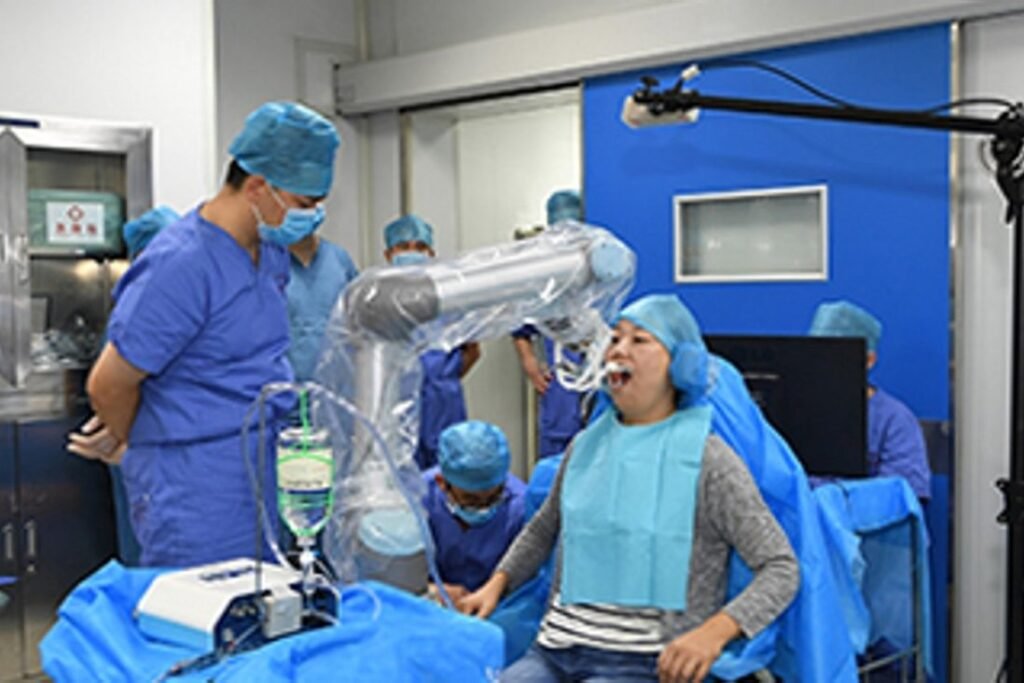
Technology has a way of entering our everyday lives, our businesses. In this era of automation and machinery no sector can remain hidden from its wonders. The Dynamic and fast-evolving field has made its mark in the dental industry as well. New technological trends pop-up every now and then, taking the industry by storm. One such unique concept is Robot dentistry.
The process of automating the clinical procedures is, however, one that has been tried and tested a number of times. Evolution of technology in this patient sensitive field has been a gradual process but lately, we can notice some exciting advancements coming up in this avenue and incorporating robotics has been one of it.
Recently, a robot ‘dentist’ in China made a successful attempt at an implant surgery without any human mediation. Reportedly, the medical staff present there only had to monitor the robot’s activity as it swiftly placed the dental device in the patient’s jaw.
The Project
This uncommon project was a result of four-years of research, development and sensitization by collaborative efforts of team of scientists from Beijing and Xian province of China. The resultant robot is now enabled to react to the patient’s movement and hence, change its position as required. The robot performed a one-hour procedure, independently placing two implants in the patient’s oral cavity, under expert supervision.
The project was conceptualized to overcome two main hurdles faced by the healthcare sector in the Chinese community: dearth of dentists and a high requirement for implant placement procedures. The Chinese healthcare surveys suggest that about 400 million citizens are in need of dental implants. The breakthrough medical advancement has now opened doors in the country for speedy and effective dental services.
Robot Dentistry in the US
The need of automation in the dental industry is also felt in developed countries of the world. The precision and ease of machine performed clinical procedures is now employed to make dental services accessible to a larger section of our society. Ventures similar to China are underway in many other countries. For example, researchers in the USA have come up with a similar robot that has managed to receive US-FDA approval, as well.
This robot however, has been made to serve only in the assisting mode. Its objective is to help in surgical procedures, making them more accurate and shorter. The robot is designed to eliminate the tedious process of using drilling templates, making sure that the drills used are controlled and in proper alignment.
Role of Dentists
With such robotic technology making its way in our clinics, one is bound to question; will dental practitioners be replaced by machines? Will machines be treating the patients in our near future?
It is imperative to understand here that the machines have been designed to provide solutions for regions where dental professionals are scarce or the population demands are overwhelming. The machines are capable of doing only what we humans have taught them, it will not be feasible to say that they can replace the human skill set or expertise entirely.
The robots can execute only according to the data steps that are fed to them and are incapable of adjusting to the patient’s need and demand. Hence, platforms of such kind can only serve in assistive capacities. Therefore, in the future, the subjective intuition and knowledge of a well-trained dentist will be supplemented by the skill-set and automation of the mechanical technology.
Robots and Patients
Amongst the technology v/s human specialization debate, another question that might arise is that whether our patients are ready to be surgically treated upon by machines?
In recent years the use of robots has gradually been increased in the dental field, with robots assisting dentists in carrying out root canal and orthodontic procedures as well as in training students. With the successful incorporation of robotics in the field of general surgery, the masses have now developed a trust in the meticulousness and error-free results delivered by the machines. They are now more open to robot performed procedures with hope of avoiding problems caused by human error and help overcome shortage of qualified dentists at the same time.
Thus, now is the best time to incorporate robotics in your clinical practice, seeing as it will prove to be a revenue-generating one-time investment to upgrade the clinical setting. After all, it is essential to enhance your technological dynamics to have a competitive edge in this fast-evolving healthcare field.
Share your thoughts in the comments below. If you found this interesting, share it with your friends and follow our Facebook page @clinicaldentalgenetics for more interesting info.
https://www.facebook.com/clinicaldentalgenetics
International Saliva Summit Of India (SALSI) 2021
[Endorsed by North American Saliva Symposium (NASS)]
First of its kind interdisciplinary virtual summit
For more details, visit:

I would like to learn robotic dental procedure